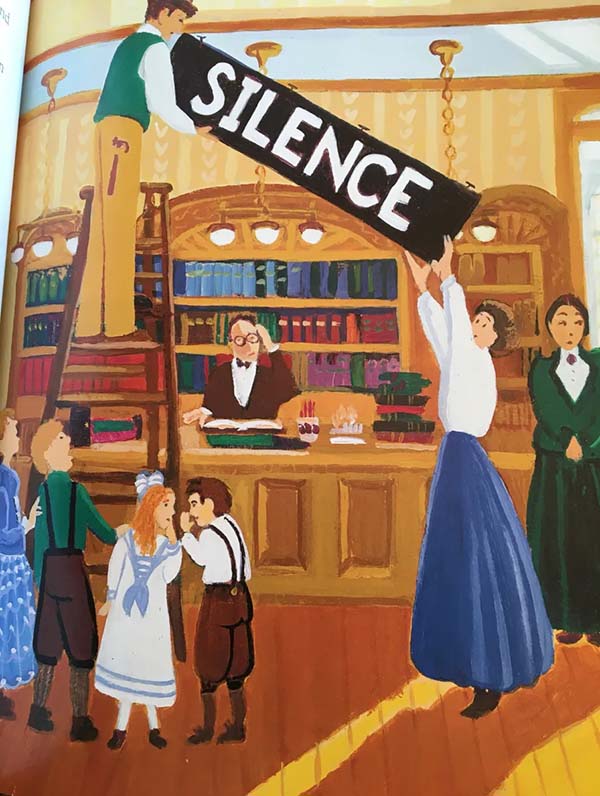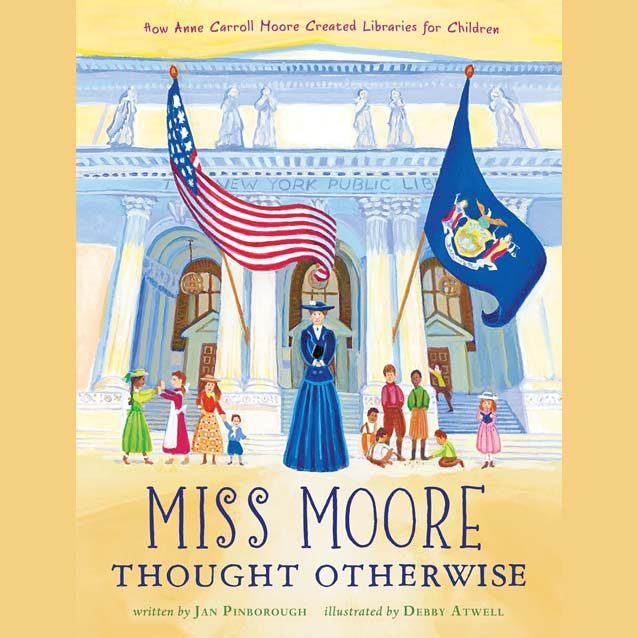Miss Moore Thought Otherwise: How Anne Carroll Moore Created Libraries for Children opens in a new tab
By Jan Pinborough
Illustrated by Debby Atwell
Clarion Books, 2013.
This book, from 2013, reminds us exactly how amazing and important the children’s library is, and how it all began. I think this picture book will be relatable to any child who has ever been to a public library. So much of what we take for granted in libraries today was almost directly a result of the work of Anne Carroll Moore as head children’s librarian for the New York Public Library. She insisted that children be allowed to come into a library and to take books home.
This biography begins almost as a fairytale. “Once in a big house in Limerick, Maine, there lived a girl named Anne Carroll Moore. She had large gray eyes, seven older brothers and ideas of her own.” Moore grew up reading and hearing stories in an era when children were not welcomed by public libraries; she later became a librarian (one of the few jobs open to unmarried women) and worked tirelessly to ensure that all children felt welcome at her library programs by creating a space just for them.
After her first job at the Pratt Free Library, Moore was offered a job overseeing the children’s sections of all 36 branches of the New York Public Library. She would go on to design the children’s room at the world-famous 42nd Street branch, which opened in 1911. We should celebrate that one person could have such an influential role in a developing field, and how independent thinking can make a difference in the world. Moore also began the cornerstone of modern children’s services, story time, by reading to children in the library. She also had furniture specially made to fit visiting children. As an author her guides and reviews of children’s books made her influential in publishing, causing an increase in the number and quality of books for children in the early twentieth century.

Miss Moore was a passionate advocate for children and even made the change of removing the “Silence” signs.
Atwell’s cozy, folk-art-style paintings brim with period details and depict multicultural patrons. She uses acrylics to capture a sense of history in the making, as well as the book’s themes of excitement and change. Atwell’s stimulating colors are a good match for the inspirational woman who insisted that children’s library space should be vibrant.
Back matter includes more details about Miss Moore, the “trailblazing librarian” with a list of sources. She retired at the age of 70 and chose to travel the U.S. to teach “others how to make good libraries for children.” Miss Moore lived until 89 years old. [1961]
Jan Pinborough is the managing editor of a children’s magazine called “Friend.” She lives in Utah. Debby Atwell is the acclaimed illustrator of several books, including these 4 books:
- Barn
- Pearl
- The Thanksgiving Door
- River
She lives in Maine.
Submitted by Karen Kosko


